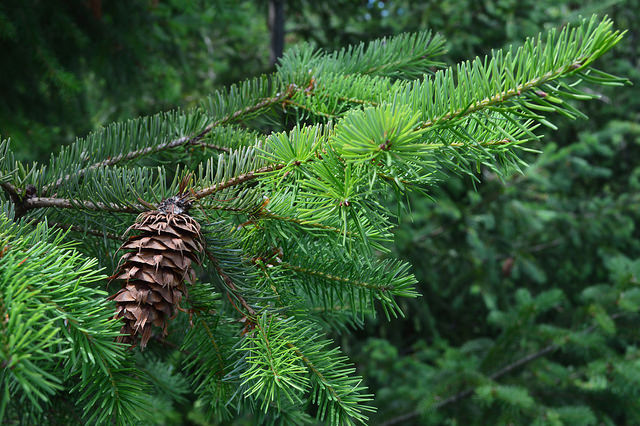This is the first of a two part series on Douglas-fir cultivars.
Introduction
Since its introduction to cultivation in 1826, Douglas-fir has become one of the world’s most popular trees. A variety of cultivars have been developed, and are available for purchase in nurseries and garden centers across the United States, Europe, and Canada. The following examines some of the most frequently selected varieties, including ‘Anguina’, ‘Argentea Compacta’, ‘Brevifolia’, ‘Carnefix Weeping’, ‘Fastigiata’, ‘Fretsii’, and ‘Fletcheri’.
Note: Each of the following cultivars are susceptible to infestation by aphids, scale, and bark beetles. Root rot is common on selections planted on heavy, wet soils with poor drainage. Fungal diseases can cause branch dieback, and significant defoliation.
‘Anguina’: ‘Anguina’ Douglas-fir is a fast growing cultivar that is renown for its twisting, irregular branches. This cultivar can reach 80 to 160 feet in height, with a 20 to 30 foot spread. The needles are flat, soft, and thin. The foliage is a soft green. ‘Anguina’ Douglas-fir flourishes when exposed to full sun, and slightly acidic soil. While otherwise hardy, ‘Anguina’ Douglas-fir is susceptible to desiccation from heavy winds.
‘Argentea Compacta’: ‘Argentea Compacta’ Douglas-fir is a dwarf cultivar that is spherical in shape, and has distinct silver to gray foliage. It is a fast growing tree that can reach up to 12 feet in height, with a 5 foot spread. The needles are flat, soft, and thin. This cultivar is vulnerable to wind damage.
‘Brevifolia’: ‘Breviolia’ Douglas-fir is a dwarf cultivar that can reach up to 12 feet in height. It is pyramidal in shape, and features dense green foliage. The tree branches out in a horizontal fashion, with the branch tips growing upward. The needles are flat, soft, and short. ‘Brevifolia’ Douglas-fir requires full sun, and slightly acidic soil to thrive.
‘Carnefix Weeping’: ‘Carnefix Weeping’ is a cultivar of Douglas-fir with a spiraling growth habit, and long, pendulous branches. It is sometimes called ‘Idaho Weeper’. The plant is covered in dark green needles that are flat, soft, and thin. It is a fast growing cultivar that can reach heights of 15 to 20 feet, with a 5 to 10 foot spread. This cultivar should be exposed to full sunlight, and rooted in moist, well-drained soil.
‘Fastigiata’: ‘Fastigiata’ Douglas-fir is notable for its dense, pyramidal form. It grows up to 40 feet tall, with a 10 to 15 foot spread. The branches have a distinctly upright growth habit. They form a spire of dense, flat green-gray needles. This cultivar prefers sunny locations, with moist, slightly acidic soil. It is commonly used as a screen planting.
‘Fretsii’: ‘Fretsii’ Douglas-fir is a small tree that has a dense, pyramidal shape, and short, broad needles with blunt tips. This tree develops at a fast rate. It can grow up to 20 feet in height. The tree grows best in full sun, and slightly acidic soil.
‘Fletcheri’: ‘Fletcheri’ Douglas-fir is a popular dwarf shrub form with a rounded shape. It is a slow growing tree, typically reaching heights of 3 to 6 feet, with a 3 foot spread. This cultivar develops attractive blue to green needles. The needles are thin and soft. The crown of the tree is flat. The tree is most partial to full sun, and moist, slightly acidic soil.
Photo courtesy of UBC Micrometeorology CC-by-2.0


